Vol. 8, Issue 2, pp: (378-397), Month: October 2020 - March 2021, Available at: www.researchpublish.com
RISK FACTORS THAT LEAD TO FEMALE INFERTILITY
MUGHNI SABRINA PROGRAM STUDI PENDIDIKAN DOKTER FAKULTAS KEDOKTERAN UNIVERSITAS UDAYANA, BALI, DENPASARAbstract: Infertility happened when a couples age over than 30s with frequent intercourse trying to get pregnant for at least a year with no success. This proposal will be concentrate on the risk factors that can cause female infertility in women. Common thing about this, people know that female infertility is about women age over 30s had difficulty in having a child considering all the causes and risk factor that leads to infertility. As for the treatment, there are many of treatment that available but it is very difficult to diagnose and prevent the cause of fertility.1
This study was using questionnaire survey method. This method was carried out by random distributing the questionnaire to semester 1 till semester 7 female medical student of Udayana University. Regarding this sensitive issue only 80 people willingly to participate. This shows the interest that every female medical regarding this issue.
Keywords: risk factor, female infertility, women age, treatment, female medical student.
1. INTRODUCTION
Infertility happened when a couples age over than 30s with frequent intercourse trying to get pregnant for at least a year with no success. This proposal will be concentrate on the risk factors that can cause female infertility in women. Common thing about this, people know that female infertility is about women age over 30s had difficulty in having a child considering all the causes and risk factor that leads to infertility. As for the treatment, there are many of treatment that available but it is very difficult to diagnose and prevent the cause of fertility.1
The World Health Organization definition based on 24 months of trying to get pregnant is recommended as the definition that is useful in clinical practice and research among different disciplines. All over the World it affects an estimated 10%15% of couples of reproductive age. Recently, the number of couples seeking treatment for infertility has dramatically increased.2 In general, among infertile couples, women show higher levels of distress than their male partners. Various research studies support the theory that distress is associated with lower pregnancy rates among women pursuing infertility treatment. The factors include age, duration of menstrual cycles, dysmenorrhea, hyperprolactinemia, recent weight gain, body mass index (BMI), ovarian dysfunctions, thyroid disorders and uterine abnormalities.3
There are also a few risk factors that will be discussed below can effect through their daily lifestyle such as age factor, weight, smoking, alcohol, hormones, occupational and stress emotion. This all are the risk factors that will be discussed further in this proposal on how to prevent them from infertility through their lifestyle.
2. LITERATURE REVIEW
As from the background about female infertility, these conclude there are lots of factor that can be seen or known or studied. As for this proposal, only few will be mentioned such as age, weight, hormone, smoking, alcohol, stress emotion, occupation and more. These are the few factors that will be discussed in this proposal as this are all the things that human did in their daily life without knowing it can leads them to infertility especially for women.
Despite the fact that various studies have demonstrated the importance of the mind–body connection and fertility, the psychosocial aspects of infertility have not been adequately addressed. Psychological factors such as depression, state-
(Online)
Vol. 8, Issue 2, pp: (378-397), Month: October 2020 - March 2021, Available at: www.researchpublish.com
anxiety, and stress induced changes in heart rate and cortisol are predictive of a decreased probability of achieving a viable pregnancy. A couple that is trying to conceive will undoubtedly experience feelings of frustration and disappointment if a pregnancy is not easily achieved. Daily lifestyle of risk factors lead to infertility among women includes:
Physicians need to informed who are involved in the primary care of reproductive-age women of the specific relationships between lifestyle choices and infertility so that they can use this knowledge to educate their patients and encourage changes in behavior The prevention of chlamydial and gonorrheal infections; maintenance of the proper body weight; increased individual awareness about the effects of age on fecundity; and reduced intake of caffeine, tobacco and alcohol are all possible avenues for primary prevention of infertility. Lifestyle choices can be made that influence the reproductive capability of women. It may be worthwhile for primary care physicians to use information on lifestyle to encourage their patients to improve their overall health while positively affecting their ability to reproduce.
Table 1: Public Knowledge of the Risk of Smoking
Smoking risk Knowledge of risk
Lung cancer 99%
Respiratory disease 99% Heart disease 96% Miscarriage 39% Osteoporosis 30% Ectopic pregnancy 27% Infertility 22% Early menopause 17%
2.1 Formulation of Problem
2.1.1General problem
a) How to prevent students from infertility through daily lifestyle? b) What are daily lifestyles in medical students that can leads to infertility?
2.2 Research purpose
2.2.1Aim
a) To study more about the risk factor in female infertility
b) To study more about the prevention of infertility towards current generation
c) To know the frequency of risk to infertility among students lifestyle
2.2.2 Specific aim
a) To know more about the risk factor that can cause female infertility b) To know the prevention for female infertility
International Journal of Healthcare Sciences ISSN 2348-5728 (Online)
Vol. 8, Issue 2, pp: (378-397), Month: October 2020 - March 2021, Available at: www.researchpublish.com
2.3 Benefits
1.
For medical students
- As a future doctor and current medical student conducting experiment on this specific topic would give them more general knowledge about the usage and advantage of risk factor in infertility.
2.
For the writer
- Writer can understand better about this infertility and present better on this elective study.
3. For society
- They could know the basic knowledge of risk factor in female infertility and maintain their healthy life organically.
- They could apply this knowledge if they found one of their relation fulfilling the sign and symptom of any mild reproductive problem and overcome it naturally.
3. DEFINITION
Female infertility commonly refers to infertility happened in females. In other words, it means female whom not able to reproduce or getting pregnant. Mostly this happened in woman whom more than 35 years old or after one year of massive intercourse. The causes are depends on the symptoms including the risk factors that leads to infertility. Couples with a reasonably good prognosis may be encouraged to wait till the exact time because even with treatment they do not have a better chance of conceiving. The others may benefit for infertile female can start from an early resort to assisted reproduction treatment. (C.Gnoth, May 2005, Oxford Journal)
3.1 Etiology
There are some causes that leads to infertility include: a) Hormones b) Smoking c) Alcohol d) Occupational e) Stress emotion f) Age g) Weight h) Endometriosis pain i) Infection
3.2 Sign and Symptoms a) Abnormal periods b) Weight c) Feeling anxiety d) Feeling depress e) Endometriosis pain f) Low self-esteem (J.Chikel, December 2004, European Obstetrics and Gynecology and Reproductive Biology)
3.3 Diagnosis
To diagnosed infertility, there are many types of tests that can be done to diagnose an infertility of a female. For an example are lab test, measuring thyroid function, laparoscopy and Hysterosalpingography. Meanwhile some research suggested that it is more exact to use Polymerase Chain Receptor (PCR). Known PCR will only be used to diagnose
International Journal of Healthcare Sciences ISSN 2348-5728 (Online)
Vol. 8, Issue 2, pp: (378-397), Month: October 2020 - March 2021, Available at: www.researchpublish.com
Tuberculosis (TB) patients. But since TB is one of the causes that can cause infertility, some doctors will be using this method to diagnose infertility patients. Since PCR are used to diagnose TB patients, it is also rapid, sensitive and specific molecular biological method for detecting mycobacterial DNA in both pulmonary and extra-pulmonary samples from patients. PCR assays targeting various gene segments, including a 65 kDa protein-encoding gene, the IS 6110 element and the mpt64 gene have abbreviated the turnaround time for definitive mycobacteriological detection in the laboratory to 1–2 days, besides being more sensitive than conventional methods. (N.Vijaya Bhanu, October 2005, Journal of Medical Microbiology)
3.4 Differential Diagnosis
Differential diagnosis such as
a)
Hypothalamic
- Causes of female infertility should be considered in an appropriate clinical context, with tests pointing to a hypogonadotropic hypogonadism. It can be functional, physiological or related to organic causes.
b) Hyperprolactinemia

- Well characterized effects on the normal gonadal function and treatment is well established.
c) Acromegaly and Cushing’s disease
- Impair fertility at different level; mechanisms involved however remain ill defined.
d)
Thyroid disorders
- Hyperthyroidism and Hypothyroidism, can interact with the ovaries, through a direct effect on ovarian function, but autoimmunity may be involved, as well as alterations of the sex hormone binding protein levels. (David Unuane, December 2011, Best Practice and Research Clinical Endocrinology and Metabolism)
4. CONCEPT
Daily Lifestyle Risk Factor of Infertility in Female
AGE WEIGHT HORMONE ALCOHOL
5. RESEARCH DESIGN
INFERTILITY
This study is a descriptive cohort study to determine the total number that student from batch 2013 in Udayana Faculty in a risk of having infertility. This is an epidemiology studies in which participating individuals are classified either having some outcome, the outcome from student daily activities and family histories might associated with the outcome. The advantage of this research is usually will take a short time to complete the outcome.
5.1 Place of research
This place will be conducted at the Udayana faculty in Denpasar, Bali.
5.2
Time research
This research will be conducted in October 2016.
International Journal of Healthcare Sciences ISSN 2348-5728 (Online)
Vol. 8, Issue 2, pp: (378-397), Month: October 2020 - March 2021, Available at: www.researchpublish.com
5.3.
Subject and sample
5.3.1 Target population
The target population of this study is the students from 2013 batch in Faculty of Udayana in Denpasar, Bali.
5.3.2 Accessible population
Research will be conducted in December 2016 at Faculty of Udayana for female students.
5.4 Size sample
Size of sample data research is based on the data which will be collected based on criteria of sample which is the number of female students that are in risk in having infertility in Faculty of Udayana from 2013 batch.
5.4.1 Methods of sampling techniques
Research data in a class in a group of female students that have the risk having infertility by using a formula.
5.5 Variable Identification
5.5.1
Operational definition

Since female infertility only happen to women with age over 30’s, students or youngster in early age can leads to infertility without realize the risk factor that can cause infertility itself. 5.5.2 Risk factor of female infertility includes:
5.7 Research protocol
Research protocol or procedures of this research is divided into the component which is the preparation stage, implementation stage and analysis stage.
Preparation stage
1. A bit of background about female infertility and mostly the risk factors have been studied. 2. General understanding about the general knowledge the risk factors are completed.
3. The topic of research has been narrow down to only for medical students in 2013 batch in Faculty of Udayana
International Journal of Healthcare Sciences ISSN 2348-5728 (Online)
Vol. 8, Issue 2, pp: (378-397), Month: October 2020 - March 2021, Available at: www.researchpublish.com
Implementation stage
1. questionnaire have been prepared about the general knowledge of female infertility and some questions to be answered.
2. Questionnaire is made to survey and contributed to the students from 2013 batch. In this stage, data has been collected through the sample population.
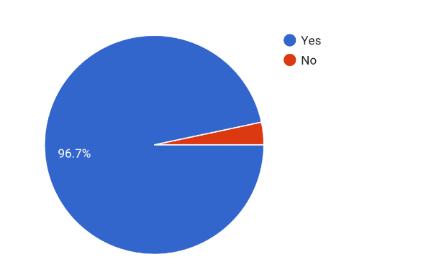
Analysis stage
1. Analysis stage is carried by the questionnaire that has been distributed to students. After the analysis, final arrangement of the report is done.
2. Further observation or discussion will be done to get accurate information and result from the surveys that have been distributed.
5.8 Data Analysis
1. Data will be analyzed easily using bar charts.
5.9 Research disadvantage
- The disadvantage for this research is where a lot of research and journals have to be search and browse through the internet to get the correct and accurate information. Moreover, a lot of it is very hard to get a sample for female who actually go through infertility to get the right analysis and studies.
6. DISCUSSION
From the above chapters, all was discussed about the major risk can be seen in daily lifestyle that can cause infertility in female. Some have been list out among the other factors as hormone as the major one, followed with smoking, alcohol, age, occupational and stress. These questionnaires have been distributed to 150 Udayana Univertsity students from the Medical Faculties. The purpose for this is to see whether the medical students especially female are aware about infertility and the things that can cause infertility itself in their daily life. From the questionnaires that showed from the pie char below, these are the knowledge or understanding that most students knows about infertility.
Most of them know that the major risk factor that can cause infertility is the increase in hormone, followed with smoking, occupational, caffeine, stress and alcohol. 99.9% of them agree that hormone were the major risk that caused infertility. Only 50% of them have a balance menstrual cycle while the other going through imbalance hormone in their monthly cycle. The bowel pain that was felt in females every month like cramp and so one, 50% of them felt the pain but the 40% did not feel any pain and for the 10% are causes of others.
Charts below shows the knowledge percentage about few major risks of female infertility in daily lifestyle
International Journal of Healthcare Sciences ISSN 2348-5728 (Online)
Vol. 8, Issue 2, pp: (378-397), Month: October 2020 - March 2021, Available at: www.researchpublish.com
Chart 2
Menstrual cycle balance every month
Chart 3
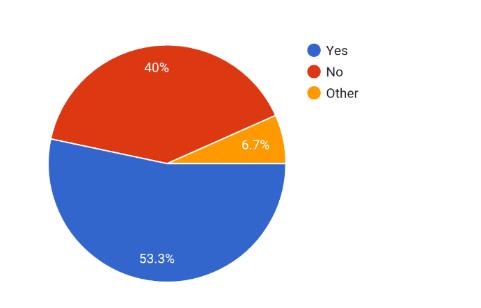
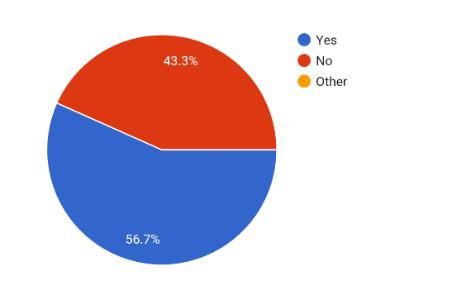
Any bowel pain?
Chart 4
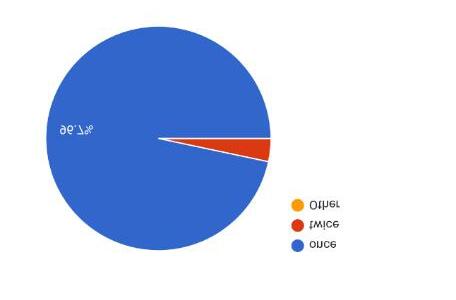
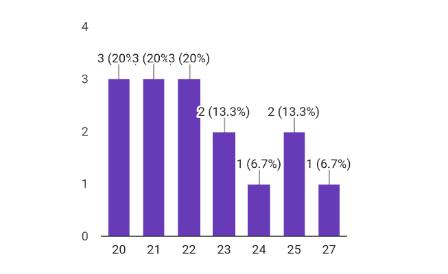
Times get menstrual in a month
Chart 5
International Journal of Healthcare Sciences ISSN 2348-5728 (Online)
Vol. 8, Issue 2, pp: (378-397), Month: October 2020 - March 2021, Available at: www.researchpublish.com
Experience imbalance hormones
Chart 6
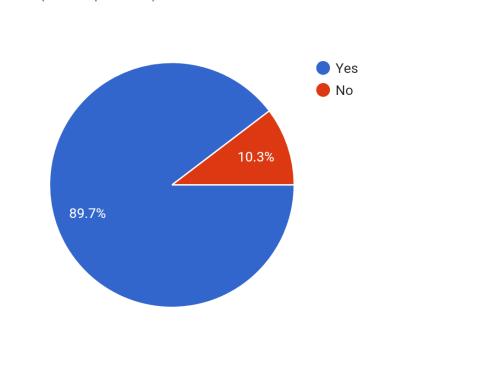
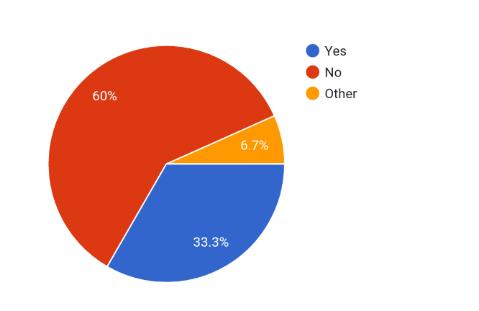
Smoking Chart 7
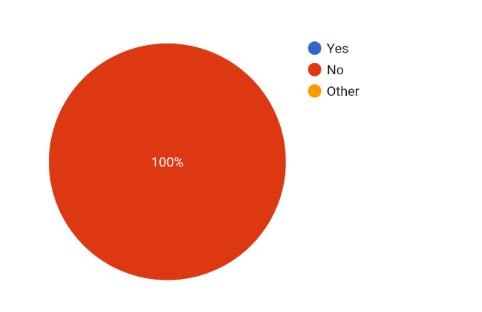
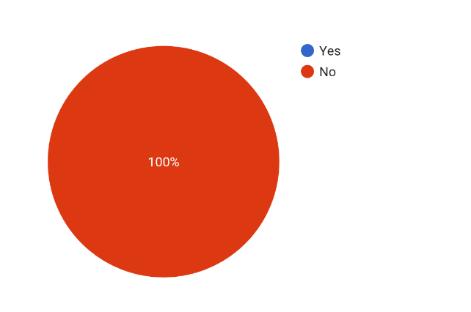
Smoke more than a packet of cigarettes
Chart 8
Smoking leads to infertility
Chart 9
International Journal of Healthcare Sciences ISSN 2348-5728 (Online)
Vol. 8, Issue 2, pp: (378-397), Month: October 2020 - March 2021, Available at: www.researchpublish.com
Smoking effect monthly menstrual
Chart 10
Feel any imbalance hormone after smoke
Chart 11
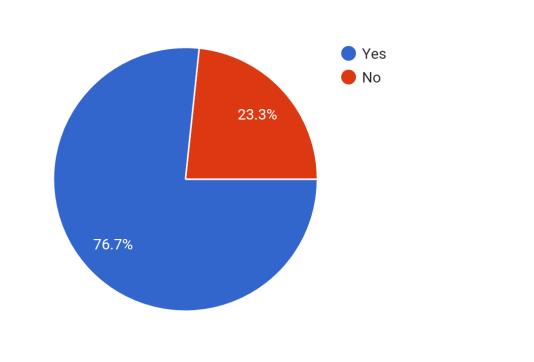
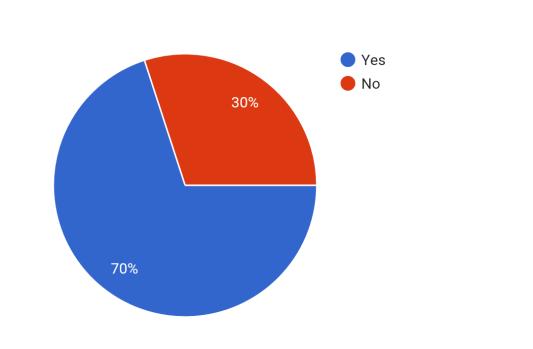
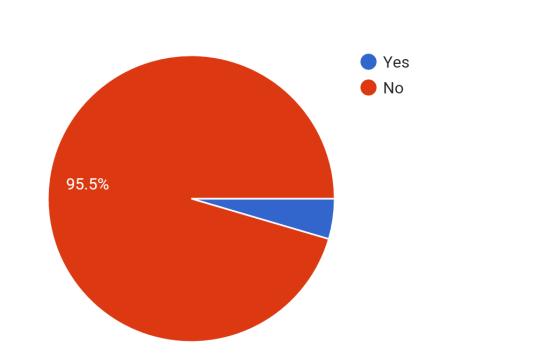
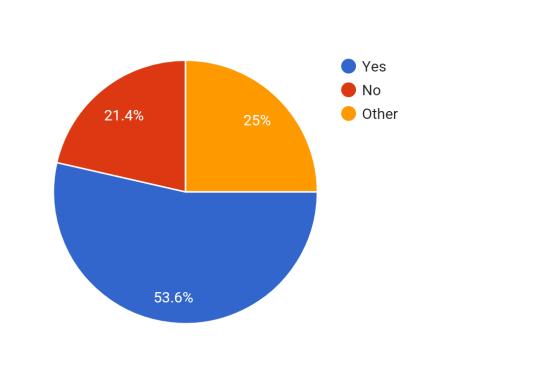
Occupation
Chart 12
Job can cause infertility
Chart 13
International Journal of Healthcare Sciences ISSN 2348-5728 (Online)
Vol. 8, Issue 2, pp: (378-397), Month: October 2020 - March 2021, Available at: www.researchpublish.com
Chart 14
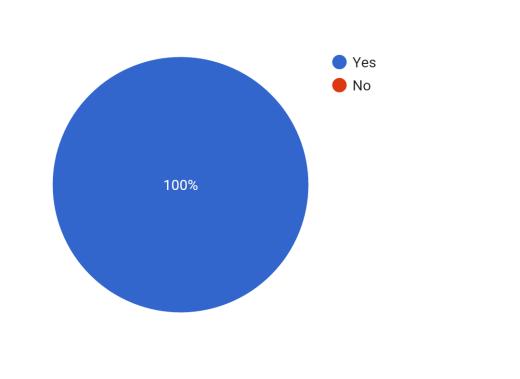
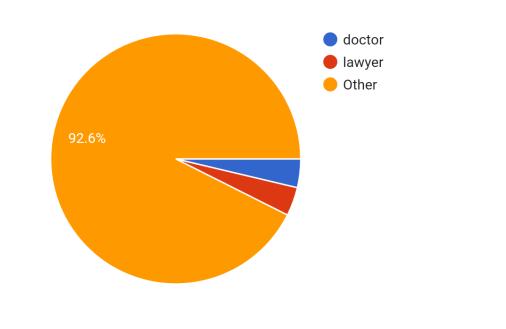
Exposed to pollutant
Chart 15
Working hour in a day
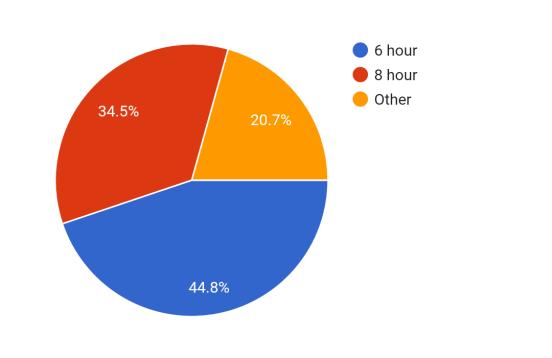
Chart 16
Stress
Chart 17
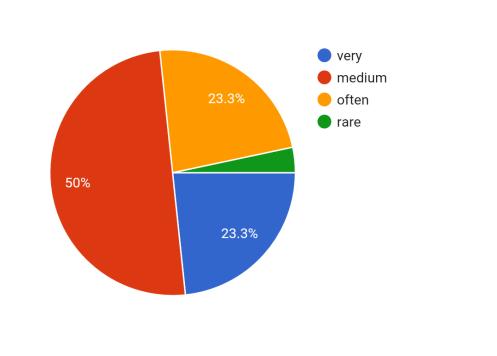
International Journal of Healthcare Sciences ISSN 2348-5728 (Online)
Vol. 8, Issue 2, pp: (378-397), Month: October 2020 - March 2021, Available at: www.researchpublish.com
Mother should be trained how to control stress to prevent infertility
Chart 18
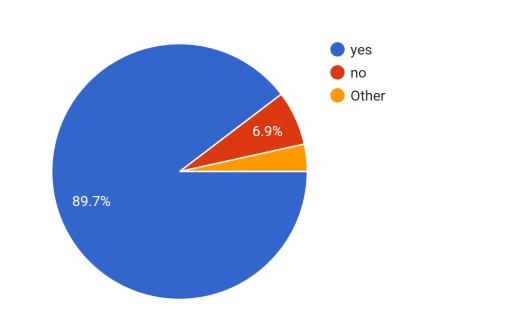
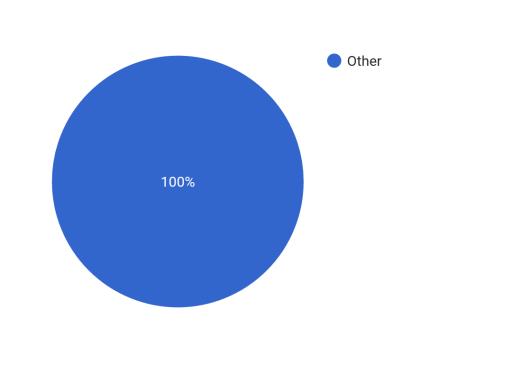
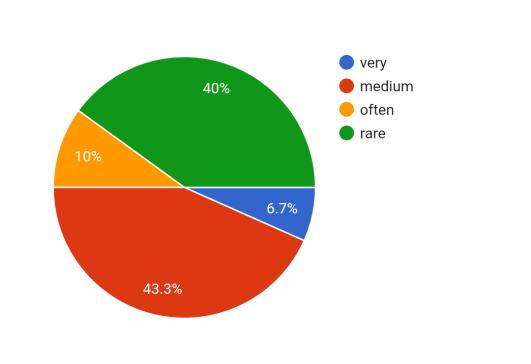
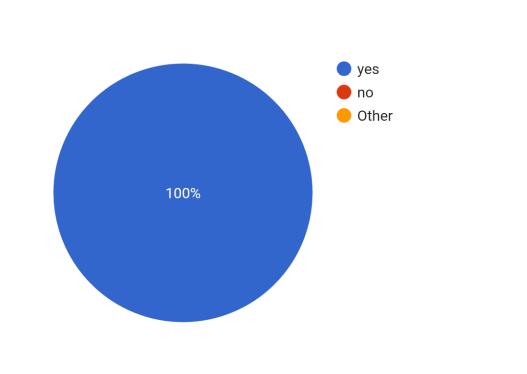
Stress experience in daily life
Chart 19
How you handle stress?
Chart 20
Stress can give big impact to women
Chart 21
International Journal of Healthcare Sciences ISSN 2348-5728 (Online)
Vol. 8, Issue 2, pp: (378-397), Month: October 2020 - March 2021, Available at: www.researchpublish.com
Caffeine
Chart 22
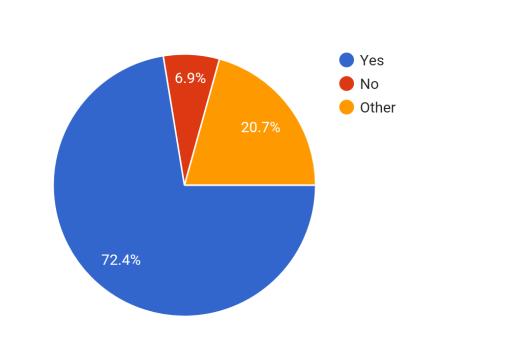
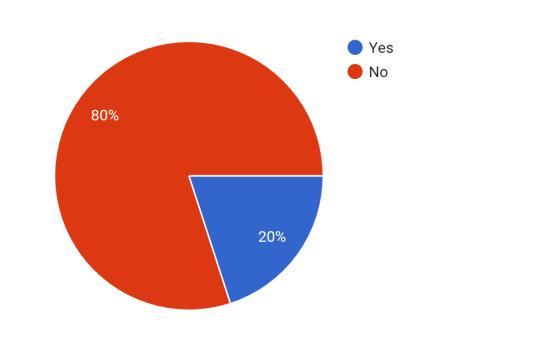
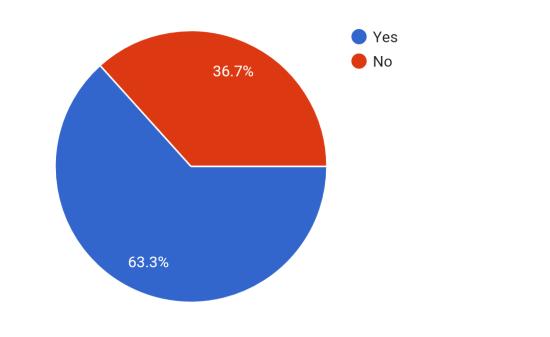
How many times drink a day?
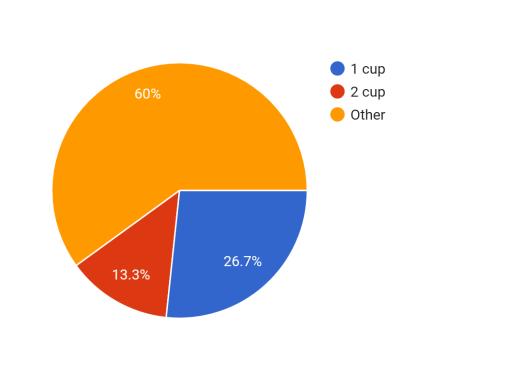
Chart 23
Addicted to coffee?
Chart 24
Coffee dangerous for pregnant women?
Chart 25
International Journal of Healthcare Sciences ISSN 2348-5728 (Online)
Vol. 8, Issue 2, pp: (378-397), Month: October 2020 - March 2021, Available at: www.researchpublish.com
Lessen coffee intake after this?
Chart 26
Alcohol
Chart 27
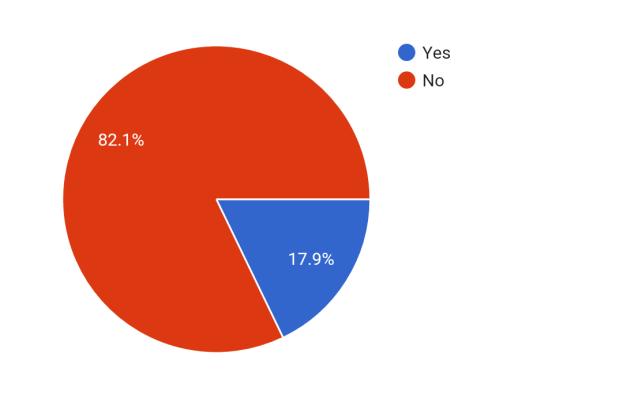
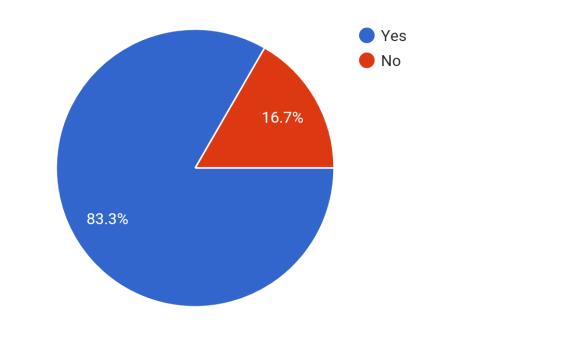
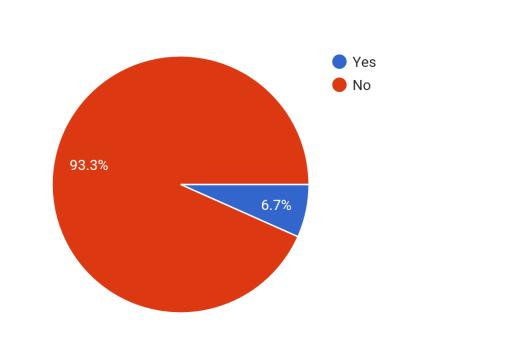
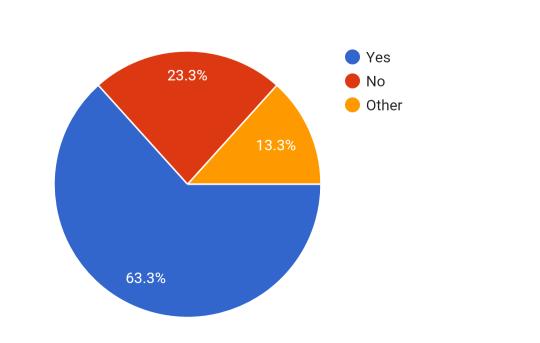
Alcohol leads to fertility
Chart 28
Drinks more than a glass or bottle
Chart 29
International Journal of Healthcare Sciences ISSN 2348-5728 (Online)
Vol. 8, Issue 2, pp: (378-397), Month: October 2020 - March 2021, Available at: www.researchpublish.com
Often consume alcohol?
Chart 30
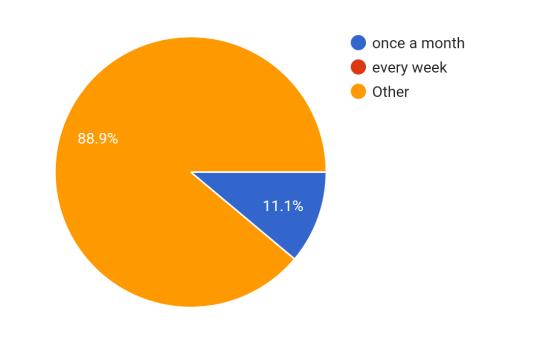
Age
All report a consistent and statistically decline in fertility synchronized with the increase of female age. The magnitude of this decline is clinically and socially important. The average age of these women was 35.2 years, Women in the age range of 25–29 years undergoing fresh non donor treatment cycles, achieved a live birth rate of 25.9%, contrasting starkly with the 6.1% rate of live birth of women 40–44 years. (Marcelle chedars, the journal of clinical endocrinology and metabolism, January 2009)
Smoking
The early stage of menopause associated with smoking suggests an association with early follicular depletion, while according to meta-analysis, the odds ratio for the risk of infertility in women smokers versus non-smokers was 1.60. Studies showed that this also showed that smoking results in a delay of conception by more than a year. Compared with the non-smokers, women smokers have decreased ovarian response to hyperstimulation, lower clinical pregnancy rate, and lower AMH levels. Smoking is also associated with many earlier pregnancy complications including spontaneous miscarriages, bacterial vaginosis, preterm labor, and ectopic pregnancy. However, with smoking cessation, fecundity returns to a similar rate as to non-smokers, even if cessation occurs within one year of attempting conception. For infertile women, simply discussing and providing basic information on the effects of smoking on infertility is highly effective in achieving smoking cessation (Samiksha Sharma, 2015, international journal of pharmaceutical sciences and research)
Smoking
smoking leads to infertility effect monthly menstrual have imbalance hormone after or before smoke
Alcohol
A Swedish study followed a cohort of 7393 women over 18 years. Information was collected on rates of attendance to hospital for various reasons including infertility examinations. During this period, almost all infertility examinations in Sweden were treated in hospitals. A questionnaire at the beginning of the study was used to assess alcohol intake and medical records were reviewed for admissions for infertility. The effect of high or low alcohol use was compared with moderate use. Levels of alcohol consumption, greater than 140 g/week, had a higher risk of undergoing an examination for infertility and the risk for low consumers, <50 g/week, was lower. Therefore, this study demonstrated a dose–response relationship between level of alcohol consumption and fertility examinations. Limitations of the study include the single point collection of data on alcohol consumption prior to the start of the study and no analysis of smoking and lifestyle. (Marcelle chedars, the journal of clinical endocrinology and metabolism, January 2009)
International Journal of Healthcare Sciences ISSN 2348-5728 (Online)
Vol. 8, Issue 2, pp: (378-397), Month: October 2020 - March 2021, Available at: www.researchpublish.com
alcohol
alcohol leads to infertility?
how many glass or bottle?
how often consume alcohol? drink?
Caffeine
There are also varying results among women undergoing assisted reproductive technology (IVF). In a cohort study of 619 women undergoing in-vitro fertilization (IVF), caffeine intake did not reduce overall pregnancy rate, however a reduction in the number of retrieved eggs was observed. These findings are consistent with a larger, prospective study that demonstrated that compared with women who do not drink caffeine, the likelihood of live birth was not significantly different for women who drank low from 0–800 mg/week, moderate >800–1400 mg/week, or high levels of caffeine >1400 mg/week. Typically there are roughly 95 mg of caffeine in an 8-ounce cup of coffee. Neither the type of caffeinated drink nor men’s caffeine intake had a significant effect on live birth rate. However, increasing caffeine use had a significantly lower peak estradiol level, but no difference in number of oocytes retrieved, fertilization or implantation rate. (Samiksha Sharma, 2015, international journal of pharmaceutical sciences and research)
caffeine
coffee in a day addicted to coffee agree coffee can cause infertility?
Weight
A studies has been found where they found data from the nurses' health study from 116 678 American nurses, where the nurses was examined by Rich-Edwards et al. the effect of BMI towards adolescent at the age of 18 year old have been studied and examined, result showed that women with BMI of 24-25.9 have the higher risk in getting infertility compared to women with BMI 2-21.9. The risk of infertility with increasing BMI was apparent for women with and without polycystic ovarian disease. (Samiksha Sharma, 2015, international journal of pharmaceutical sciences and research)
Psychological Stress
Stress can be the major problem that everyone will have to go through every day. Stress also one of the major risk factor in female that can leads to infertility. Below pie chart shows how much stress student going through in their daily life. 6.7% of them actually going through this psychological stress while the remaining is mostly often feel the stress in their daily activity. Most of them agreed to the statement that stress really can cause infertility especially for pregnant mother and miscarriage can happen if this still going on. To prevent this, it is better for mother or women to take a day off once in a week to relief the stress by doing something that they like or find it enjoy for them.
Cognitive behavioral therapy as well as the mind body intervention is one of the treatments that works well for patient with anxiety and stress respond. In the other way, yoga is also one of the treatment that respond well as it is one of the method of stress management and relaxation that may beneficial for women undergoing fertility treatments. This may
International Journal of Healthcare Sciences ISSN 2348-5728 (Online)
Vol. 8, Issue 2, pp: (378-397), Month: October 2020 - March 2021, Available at: www.researchpublish.com
help the woman communicate more clearly with physicians, maintain a healthier lifestyle, and be patient through the sometimes long and cumbersome fertility treatments. (Marcelle chedars, the journal of clinical endocrinology and metabolism, January 2009)
psychological
stress
very medium often
Occupation
Occupation actually give effect to infertility as people most of the time will be exposed to outside pollution which they might or might not know that it can give effect to their body. As it shows in the result, 98% of the sample work as a student and some already think that they already become a doctor in this case. Students tempt to confuse whether work can cause infertility. This is because they seem to think that hormones are the biggest risk that can cause infertility. 70% of them agree that job can cause stress which leads to infertility for mothers, but still quite few disagree with this statement.
A result showed reduced implantation rate was found in women whose partners worked in occupations with high levels of organic solvent exposure. There also evidence of an adverse effect of some pollutants and chemicals on human reproduction and of an association with exposure to other environmental factors. This improved the existing knowledge in this area and couples attempting pregnancy should be given individually counseled regarding any potentially harmful occupational exposures but still more studies should be done. (Samiksha Sharma, 2015, international journal of pharmaceutical sciences and research)
occupation
job can cause infertility job causes stress job they work as exposed to pollutant
REFERENCES
[1] Abha Maheshwari, 14 December 2007, Oxford Journal in Human Reproduction http://humrep.oxfordjournals.org/content/23/3/538.full
[2] C.Gnoth, May 2005, Oxford Journal, http://humrep.oxfordjournals.org/content/20/5/1144.short
[3] Christian J. Nelson, 28 June 2008, The Journal in Sexual Medicine, http://onlinelibrary.wiley.com/doi/10.1111/ j.1743-6109.2008.00880.x/abstract;jsessionid=3EB451783AEC4D57035985927ED25784.f02t01?userIs Authenticated=false&deniedAccessCustomisedMessage
[4] Dunsan, January 2004, Obstetric and Gynecology), http://journals.lww.com/greenjournal/Fulltext/2004/01000/ Increased_Infertility_With_Age_in_Men_and_Women.10.aspxYoublacklove
[5] David Unuane, December 2011, Best Practice and Research Clinical Endocrinology and Metabolism), http://bmcwomenshealth.biomedcentral.com/articles/10.1186/1472-6874-4-9
[6] Dr Allan Thomson, 1 September 2000, Alcoholic and Alcoholism), http://alcalc.oxfordjournals.org/content/35/5/417.full
International Journal of Healthcare Sciences ISSN 2348-5728 (Online)
Vol. 8, Issue 2, pp: (378-397), Month: October 2020 - March 2021, Available at: www.researchpublish.com
[7] H.Sekhon, May 2010, Women Health Review), http://www.sciencedirect.com/science/article/pii/ S030121150400257X
[8] Gilad Twig, May 2012, Journal of Autoimmunity), http://onlinelibrary.wiley.com/doi/10.1111/j.16000897.1992.tb00768.x/abstract
[9] G.F. Homan, January 2007, Oxford Journal), http://humupd.oxfordjournals.org/content/13/3/209.full
[10] F Grodstein, 7 October 2011, American Journal of Public Health, http://ajph.aphapublications.org/doi/abs/10.2105/ AJPH.84.9.1429
[11] J.Chikel, December 2004, European Obstetrics and Gynecology and Reproductive Biology
[12] K A Sanders, December 1997, Oxford Journal, http://humrep.oxfordjournals.org/content/12/10/2324.short
[13] Laura Bunting and Jacky Boivin, 8 April 2008. Human Reproduction, http://humrep.oxfordjournals.org/content/23/ 8/1858.full
[14] L C Layman, Journal of Medical Genetic, September 2002, http://jmg.bmj.com/content/39/3/153.short
[15] N.Vijaya Bhanu, October 2005, Journal of Medical Microbiology, http://jmm.microbiologyresearch.org/content/ journal/jmm/10.1099/jmm.0.45943-0;jsessionid=l44CMQYkEX53p9h_xBvNlp2c.x-sgm-live-02#tab2
[16] Pablo A.Nepomnaschy, American Journal of Human Biology, October 2004, http://onlinelibrary.wiley.com/doi/10.1002/ajhb.20057/abstract
[17] Sunil Kumar, September 2004, Journal of Occupational Health, https://www.jstage.jst.go.jp/article/joh/46/1/46_1_1/ _article
[18] Smith, E. M. PhD, February 1997. Journal of Occupational and Environmental Medicine, http://link.springer.com/ article/10.1007/s10815-010-9436-1
[19] T. Rajendra Kumar, 1997, Nature Genetic, http://www.ejog.org/article/S0301-2115(08)00136-X/fulltext
[20] Yoo Shin Kim, 31 May 2007, Journal of Korean Medical Association, http://humrep.oxfordjournals.org/content/20/5/1144.full.pdf+html
[21] Marcelle chedars, the journal of clinical endocrinology and metabolism, January 2009, http://press.endocrine.org/doi/full/10.1210/jcem.90.4.9997
[22] Samiksha Sharma, 2015, international journal of pharmaceutical sciences and research, http://ijpsr.com/bftarticle/female-infertility-an-overview/?view=fulltext
QUESTIONARE
International Journal of Healthcare Sciences ISSN 2348-5728 (Online)
Vol. 8, Issue 2, pp: (378-397), Month: October 2020 - March 2021, Available at: www.researchpublish.com
2. Did your menstrual cycle balance every month?
a) Agree b) Disagree c) Other : 3. Did you feel any bowel pain? a) Agree b) Disagree c) Other :
4. How many times you get menstrual in a month?
a) Once b) Twice c) Other :
5. Did you experience imbalance hormones for a long period?
a) Agree b) Disagree c) Other : Smoking
1. Are you a smoker? a) Agree b) Disagree
2. Did you smoke more than 1 pack or one stick of cigarettes one day? a) Agree b) Disagree c) Other :
3. Did you know that smoking can leads to female infertility? a) Agree b) Disagree
4. Does smoking effect monthly menstrual cycle?
a) Agree b) Disagree c) Other :
5. Did you feel any imbalance hormone after or before you smoke for the day? a) Agree b) Disagree c) Other :
International Journal of Healthcare Sciences ISSN 2348-5728 (Online)
Vol. 8, Issue 2, pp: (378-397), Month: October 2020 - March 2021, Available at: www.researchpublish.com
Occupational
1. Did you agree that any jobs can causes infertility?
a) Agree b) Disagree
2. Do you agree because of a job causes stress to mothers can leads to infertility? a) Agree b) Disagree
3. What kind of job you working now?
a) Doctor b) Lawyer c) Other :
4. How exposed are you to outside world in a day?
a) Very b) Medium c) Often d) Rarely
5. How many working hours you work in a day?
a) 6 hour b) 8 hour c) Other : Stress
1. Do you agree that mother emotional stress can affect the baby in the womb? a) Agree b) Disagree
2. Did you agree that mother should be trained how to control their stress emotional in order to prevent from infertility or miscarriage?
a) Agree b) Disagree c) Other :
3. How much stress you experience in daily life? a) Very b) Medium c) Often d) Rarely
4. How you handle your own psychological stress? Please explain.
International Journal of Healthcare Sciences ISSN 2348-5728 (Online)
Vol. 8, Issue 2, pp: (378-397), Month: October 2020 - March 2021, Available at: www.researchpublish.com
5. Stress can give a big impact to a woman and can cause infertility. How agree are you with this statement? If you didn’t agree, please explain why.
a) Agree b) Disagree c) Other : Caffeine
1. Do you know that caffeine is one of the risk factor that causes infertility? a) Agree b) Disagree
2. How many times you drink coffee in a day?
a) One cup b) Two cup c) Other :
3. Are you addicted to coffee? a) Agree b) Disagree
4. Do you agree coffee is dangerous for pregnant woman? If no, explain. a) Agree b) Disagree c) Other :
5. Would you lessen your coffee intake after knowing that coffee can cause infertility? a) Agree b) Disagree c) Other : Alcohol
1. Do you drink? a) Agree b) Disagree
2. Did you know that alcohol also can leads to infertility in female? a) Agree b) Disagree
3. Once you drink, did you drink more than a glass or a bottle of alcohol? a) Agree b) Disagree
